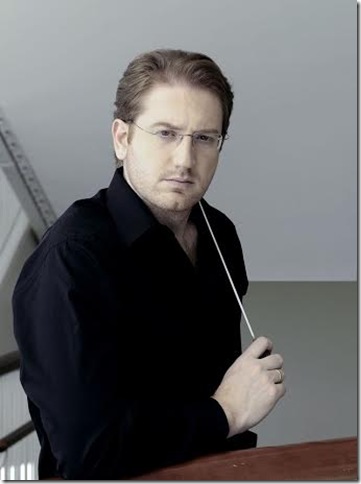Ramón Tebar must be exhausted. Twinning conductorships of Palm Beach Symphony and Florida Grand Opera in Miami would sap the energy of another man. Not so the 35-year-old Tebar. He must have the strength of Hercules.
Drawing on reserves of a champion soccer player last Sunday afternoon, April 6, he conducted a superb concert at the Kravis Center with the Palm Beach Symphony. Even more commendable, given that the night before he led the evening performance of Florida Grand Opera’s production of Tosca in Miami.
He is also a capable orchestra builder. Staffing up to 85 players from the usual 44, his glorious band filled every corner of the Kravis stage. Normally, it takes a couple of years to build an orchestra of this quality. But Tebar has managed to build an excellent ensemble in very little time.
The orchestra played three short pieces by Berlioz, Sibelius, Grieg and the huge Tchaikovsky Fifth Symphony. Berlioz’s Roman Carnival overture opened the concert. It was described as “vulgar” music by the eccentric British poetess, Dame Edith Sitwell, close friend of composer William Walton; she disliked the blazing brass chords that end it.
Tebar’s first energetic downbeat set the tone for the afternoon. And the lovely playing put everyone on notice we were in for an orchestral treat. Using arias from his rarely heard opera, Benvenuto Cellini, Berlioz fused them into this symphonic piece that has the full range of emotions and shows off each section of the orchestra. Tebar made the music sound heavenly, and yes, brassy, too.
It is the composer’s insight into Rome, a city he said “is no place for anyone with a head or a heart,’’ after finishing a year there, his reward for winning the Prix de Rome for composition. The ending long brass chord is probably his farewell “raspberry” to Rome as he departed for his beloved Paris. (Dame Edith may have had a point.)
Next came the stirring Finlandia of Sibelius. Doing his part agitating
for Finland’s independence from Russia, he revised an earlier work and named it Finlandia in 1900. Played all over Europe by the Helsinki Philharmonic, Sibelius conducting, it made him a national hero and gave him international recognition.
Finlandia begins softly. Tebar seems to make the music emanate from his very hands and fingertips, shaping each phrase lovingly. Well into the piece, Sibelius introduces the famous hymn theme — now a patriotic anthem among Finns — and widely used by religious denominations. It is at once stirring and heartrending music. It was met by thunderous applause by an audience in sync with the underlying theme of this march toward freedom and independence.
Greig’s Peer Gynt Suite No. 1, which came next, is a compilation of some of the 26 musical numbers he wrote for Henrik Ibsen’s fantasy drama of the same name.
First came “Morning,” a lilting piece suggesting the grassy slopes of Norway’s many idyllic farmlands leading down to a majestic fjord. Then “Ase’s Death,” played by just the string section. It begins quietly, the first violins playing mournful music during which one could have heard a pin drop. Third came Anitra’s Dance, a coy set of fascinating dances, just for strings, with tuneful melodies and plucked pizzicato accompaniment. The sound produced was ethereally beautiful, helping put the “world-class” stamp on the afternoon’s very fine orchestral playing.
Now the full orchestra played The Hall of the Mountain King, a furious riot of tone colors from everyone as the march-like tune builds to a dramatic end. Tremendous applause again as Tebar had each section take a well-deserved bow.
After intermission came Tchaikovsky’s Fifth Symphony (in E minor, Op. 64). Now came the real test of Tebar’s quick-time orchestra-building enterprise, which held up magnificently, except for a few fluffs from the horn section. More about them later.
The symphony opens with a clarinet, beautifully played by Anna Brumbaugh. Strings in rising scales accompany while the brass extemporize on the “motto” theme. The horns, entering ahead of the beat came in too fast, too quickly. They are meant to sound deliberate in stating the composer’s wishes. They rushed it.
In contrast, the first and second violins were perfectly drilled, bowing in unison to Tchaikovsky’s Russian-sounding music. The strings’ yearning is punctuated by three two-note attractive flute interjections. A wonderful wind-down from the five double basses ends the movement on an authoritative note.
The exquisite opening horn solo in the second movement was nothing like the radiant love song it was composed to be. It was tentative, and a few notes were fluffed. In the spotlight, the soloist had two options, improve or let everyone down. Thankfully, he managed to pull through with a rounded ending, but listeners were on tenterhooks.
Again, the strings were perfection as they took over the horn love song. Trumpets, timpani and trombones warmed up the slowness of this movement, met by plucked cellos and violas over another lovely melody from the first and second violins.
Tebar drew extraordinarily fine playing from the orchestra in the third movement, with its waltz rhythms and singing strings conjuring up grand ballrooms in Czarist Russia. The finale got off to a fine start in the strings with the Fate motif, eventually picked up by the brass. Tebar brilliantly timed the big rallentando before the big, life-affirming march that ends the symphony.
Cheers greeted orchestra and conductor, the decibel level equaled, even surpassed, by the decibel level he got from a Miami audience at a performance of Tosca I saw. A bouquet of flowers was presented to him, which he passed to the concertmaster, Evija Ozolins, who represents the orchestra. A handsome gesture.
Each section took a bow, and the standing ovation went on for a long time. People were not rushing for the doors, which says a lot about how they loved the music-making.
